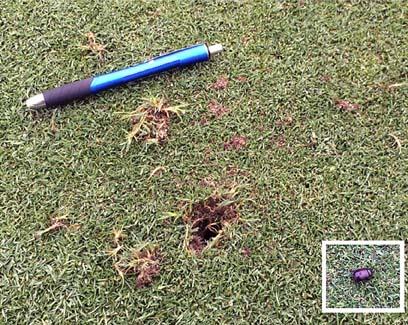 Just when you think you might have seen it all, leave it to Mother Nature to uncork a curveball, that leaves even the experts with more questions than answers.
Just when you think you might have seen it all, leave it to Mother Nature to uncork a curveball, that leaves even the experts with more questions than answers.
Late last spring, a different kind of turf pest reared its head, or more accurately its posterior, at a couple of golf courses on the Kansas side of the Kansas City City area.
The scene last June at Heritage Park Golf Course in Olathe and Dub's Dread in Kansas City was pretty much the same, said Jon Larson, Ph.D., entomologist at the University of Nebraska. Little black beetles, about a half-inch in length were partially buried headfirst in the greens.
At first glances, researchers at the University of Nebraska thought they might be sugarcane beetles, a known pest in turf, but closer inspection revealed the culprit to be its cousin the carrot beetle. Carrot beetles are nothing new, but their presence as a turf pest certainly is.
"This was the first time we had seen them on turf," Larson said.
"We don't know if they were attracted to the turf, if it was an accident, if something weird happened. We can't even figure out where they came from because there is not agricultural land surround the golf courses."
According "A Field Guide to the Beetles of North America" by Richard E. White and Roger Tory Peterson (Houghton Mifflin Harcourt) have a natural range that includes much of the United States. The larva prefer to eat the roots of carrots, celery, corn, potatoes, parsnips, beets and sweet potatoes, while the adults prefer foliage. Four-legged predators didn't much care what they were.
"The beetles themselves weren't causing a lot of damage. They were tunneling into the turf and leaving behind little holes," Larson said. "The big issue was skunks and raccoons coming in trying to gobble up these mommas that were trying to lay their eggs."
Early evidence of pests initially was confined to the collar areas, but spread throughout the greens throughout the month of June. Both courses have greens that are a mix of Poa and the old Penn bentgrasses.
Superintendents at both courses found controlling the adult population of the carrot beetle a bit more challenging than white grubs in the juvenile stages.
Superintendent Steve Stout at Heritage Park was on his new visitors nearly as quickly as the skunks, hitting them first with lambda-cyhalothrin in the second week of June. Although that appeared to knock down their numbers, skunk and raccoon damage picked up again about nine days later, prompting an application of carbaryl, according to a paper on the subject authored by Larson, Syngenta's Matt Giese and Dan Potter, Ph.D., of the University of Kentucky and just published Feb. 5.
Scott Cummins at Dub's Dread experienced similar results with lambda-cyhalothrin and followed with bifenthrin 19 days later when skunk and raccoon damage picked up again.
Larson wants to reconnect with both superintendents in the spring to learn whether this phenomenon happens again. Since carrot beetles, like sugarcane beetles, overwinter as adults and larvae hatch later in the spring than white grubs, control options will have to vary from traditional grub control programs.
"Their life cycle is opposite from white grubs," Larson said. "This beetle overwinters as adults, not grubs. And when they come out in spring, they are big, tough beetles, and they are tough to control at that point. You have to spray in mid-summer to get the larva that have just hatched out."

